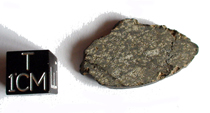Angrites
The achondrites of this group are named for their type specimen, Angra
dos Reis, a meteorite that fell in Rio de Janeiro, Brazil, in early 1869.
Angra dos Reis is a unique igneous rock that is largely composed of the
rare pyroxene fassaite, an aluminium-titanium diopside. During the last
two decades, a handful of similar fassaite-rich meteorites have been
recovered, leading to the establishment of the angrite group, presently
comprising six members.
The angrites are primarily composed of varying amounts of fassaitic
pyroxene, anorthitic plagioclase, minor olivine, kirschsteinite, along
with other accessory minerals and phases. They are basaltic rocks with
cumulate textures, often containing porous areas and abundant round
vesicles with diameters up to 2.5 cm. These vesicles have been interpreted
as remnants of gas-bubbles that formed prior to the crystallization of the
rock. However, current research suggests that the vesicles originally were
solid spheres that have been exsolved in subsequent stages of
rock-formation. Both theories are consistent with a magmatic origin of the
angrites, making them the most ancient igneous rocks known. They show
crystallization ages of ~ 4.55 billion years, which suggests their
formation occurred in the early days of the unfolding solar system. The
angrites are thought to have formed on one of the earliest differentiated
asteroids from the igneous processing of CAI-rich chondritic matter,
similar to carbonaceous chondrites of the CI or CM group.
By comparing the reflectance spectra of the angrites to that of several
main belt asteroids, two analogs were identified - 289 Nenetta, and 3819
Robinson. Further research will determine whether one of these asteroids
actually represents the angrite parent body. Only three angrites are
currently available to the private collector; these are Sahara 99555, a
single stone that was found in the Sahara desert in 1999, D'Orbigny,
an Argentinian find from 1979 that wasn't recognized as a meteorite until
1998 and NWA 1670 with a total weight of only 30gr....
|
NWA 1670 Angrite Found
: 2001 in occidental sahara,
TKW : 30.6 gr
Nwa 1670 is unique compare to the other angrites: it's highly
shocked,
it has big olivine xenocrysts and it is the most magnesian olivine
among all the known angrites.
See publication from Tokyo University and NASA:
NORTHWEST
AFRICA 1670: A NEW QUENCHED ANGRITE.
A
DISSOLVED OLIVINE XENOCRYST COMPONENT IN
THE ANGRITE MAGMA.
|
 
|
|
|
|
NWA 1670-00
2.80 gr
Full slice of angrite !
SOLD
|
|
|
|
|
|
|
|
NWA 1670-01
0.136 gr !
Very thin and nice slice !
Sold
|
|
|
|
 
|
|
|
|
|
|
|
 
|
|
|
|
NWA 1670-02
0.102 gr !
Very thin and nice slice ! SOLD
SOLD
|
|
|
|
|
|
|
|
NWA 1670-01
0.131 gr !
Two thin slice of this rare type !
Sold
|
|
|
|
  |
|
|
|
|
|
|
|